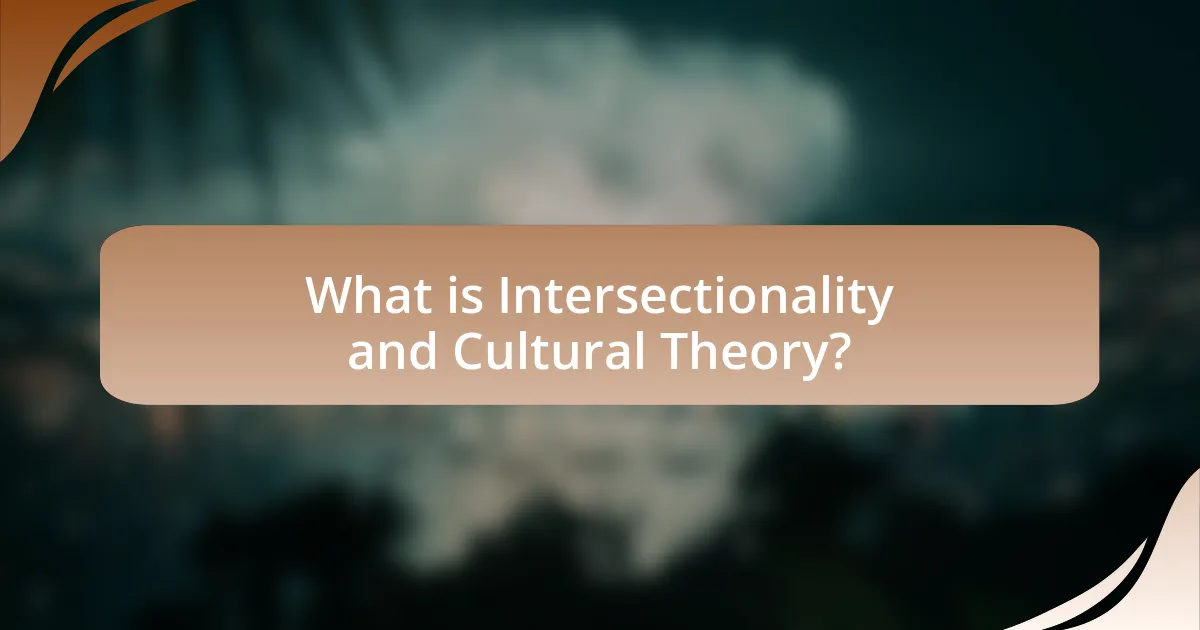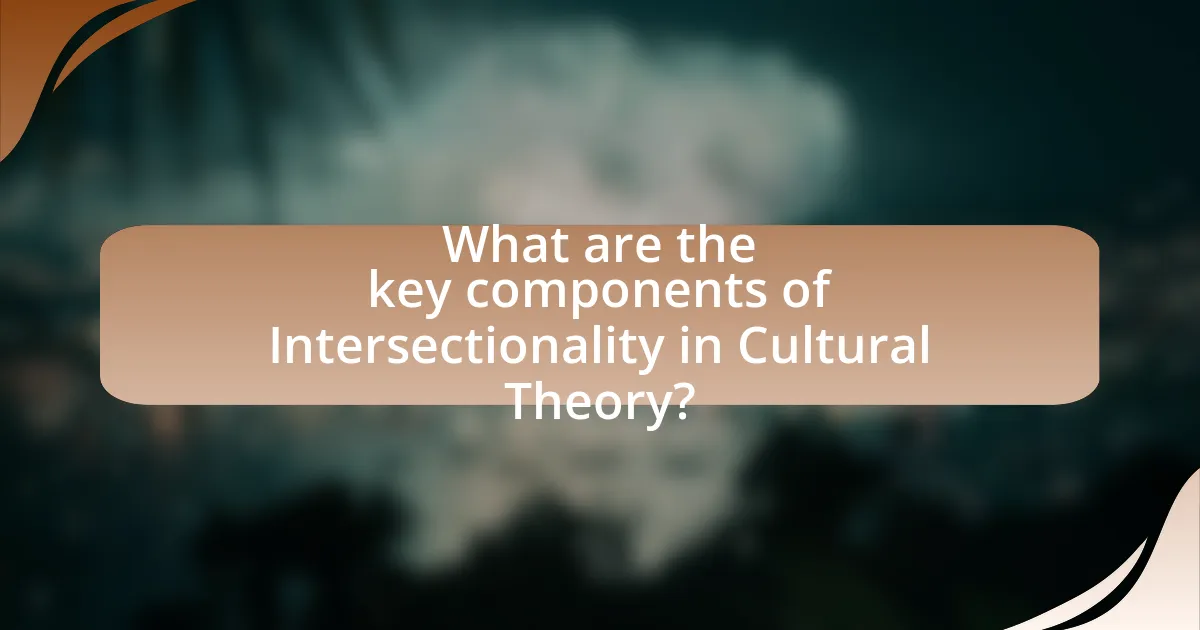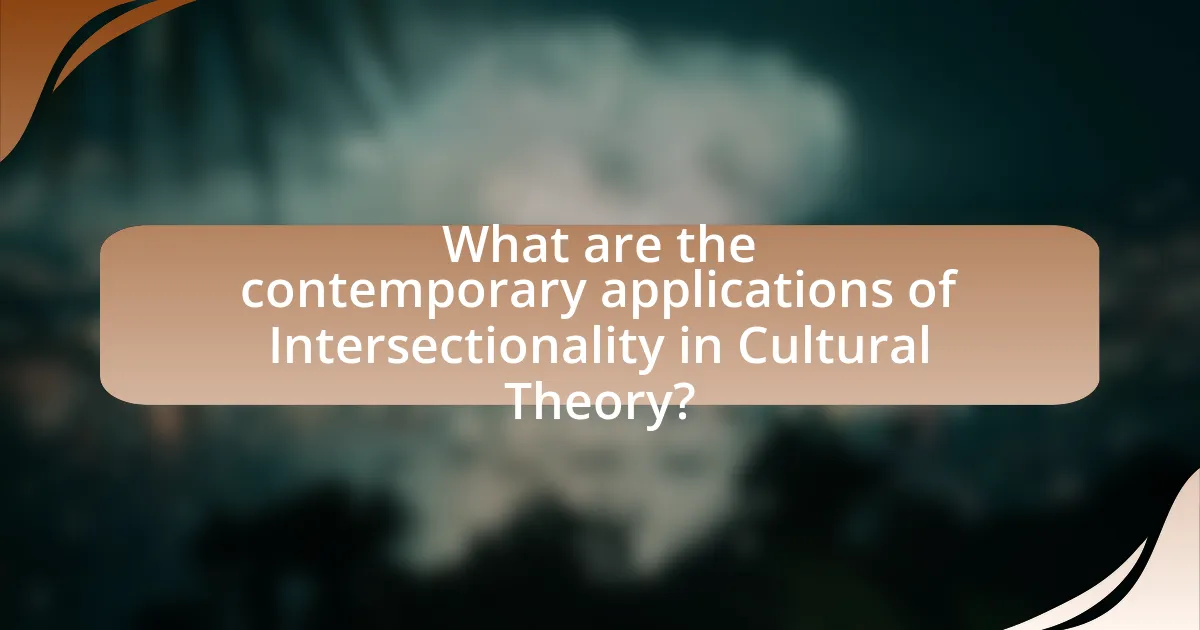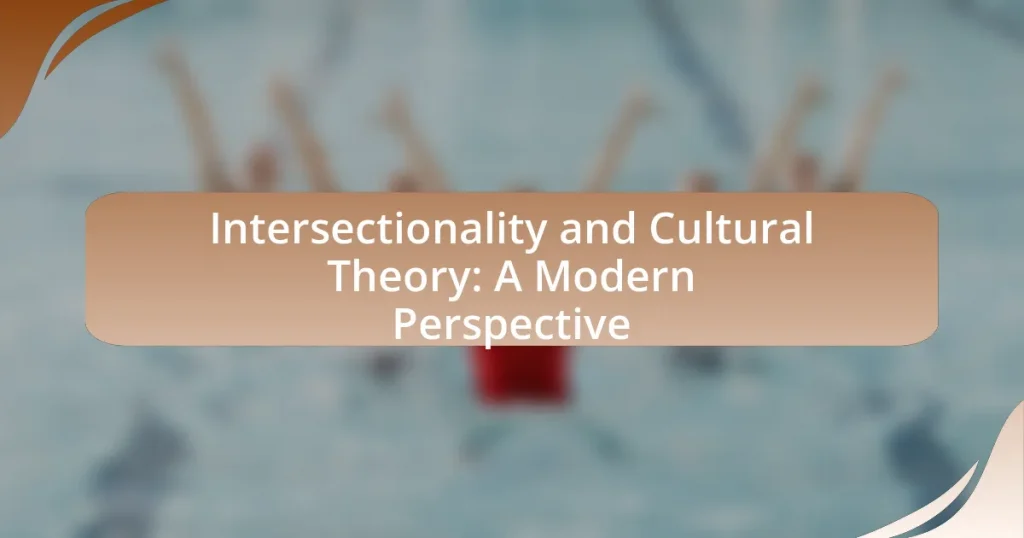Intersectionality is a theoretical framework that explores how various social identities, including race, gender, class, and sexuality, intersect to create distinct experiences of discrimination and privilege. This article examines the emergence of intersectionality within cultural theory, highlighting its historical roots in the work of Kimberlé Crenshaw and its evolution to address complex social dynamics. Key components of intersectionality are discussed, including its significance in understanding identity formation, its impact on social justice movements, and its applications across various fields such as sociology and public health. The article also addresses challenges and criticisms of intersectionality, while proposing strategies for its effective integration into cultural analysis.

What is Intersectionality and Cultural Theory?
Intersectionality is a theoretical framework that examines how various social identities, such as race, gender, class, and sexuality, intersect to create unique modes of discrimination and privilege. Cultural theory, on the other hand, analyzes how cultural practices and beliefs shape social identities and power dynamics. Together, intersectionality and cultural theory provide a comprehensive understanding of how overlapping identities influence individual experiences and societal structures, highlighting the complexity of social inequalities. This framework is supported by scholars like Kimberlé Crenshaw, who coined the term “intersectionality” in 1989, emphasizing the need to consider multiple axes of identity in discussions of social justice and equity.
How did the concept of intersectionality emerge in cultural theory?
The concept of intersectionality emerged in cultural theory primarily through the work of Kimberlé Crenshaw in the late 1980s, who introduced it to address the overlapping social identities and related systems of oppression. Crenshaw’s analysis highlighted how traditional feminist and anti-racist frameworks often failed to consider the unique experiences of individuals who belong to multiple marginalized groups, such as Black women. This foundational work was published in her influential essay “Mapping the Margins: Intersectionality, Identity Politics, and Violence against Women of Color,” which argued that social categories like race, gender, and class intersect to create complex systems of discrimination. The emergence of intersectionality in cultural theory has since influenced various fields, including sociology, gender studies, and critical race theory, by providing a more nuanced understanding of identity and power dynamics.
What are the historical roots of intersectionality?
The historical roots of intersectionality can be traced back to the work of legal scholar Kimberlé Crenshaw in the late 1980s, who introduced the term to describe how various forms of social stratification, such as race, gender, and class, intersect and create unique experiences of oppression. Crenshaw’s analysis was grounded in the experiences of Black women, highlighting how traditional feminist and anti-racist frameworks often overlooked the complexities of their identities. This foundational work was influenced by earlier movements, including Black feminism and critical race theory, which emphasized the importance of understanding multiple, overlapping identities in the context of social justice.
How has cultural theory evolved to incorporate intersectionality?
Cultural theory has evolved to incorporate intersectionality by recognizing the interconnectedness of social identities and their impact on individual experiences and systemic inequalities. Initially, cultural theory focused on singular identities, but scholars like Kimberlé Crenshaw introduced intersectionality in the late 1980s, emphasizing that race, gender, class, and other identities intersect to shape unique experiences of oppression. This shift has led to a more nuanced understanding of cultural phenomena, as seen in studies that analyze how multiple identities influence access to resources and social power, such as Patricia Hill Collins’ work on Black feminist thought, which illustrates the complexities of identity in cultural contexts.
Why is intersectionality important in understanding cultural dynamics?
Intersectionality is important in understanding cultural dynamics because it reveals how various social identities, such as race, gender, class, and sexuality, intersect to shape individual experiences and societal structures. This framework allows for a more nuanced analysis of power relations and cultural interactions, highlighting that individuals do not experience oppression or privilege in isolation but rather through a complex interplay of multiple identities. For instance, research by Kimberlé Crenshaw, who coined the term “intersectionality,” illustrates how Black women face unique challenges that are not fully addressed by looking at race or gender separately. This understanding is crucial for developing inclusive policies and practices that acknowledge and address the diverse experiences within cultural contexts.
What role does intersectionality play in identity formation?
Intersectionality plays a crucial role in identity formation by recognizing that individuals possess multiple, overlapping identities that influence their experiences and perspectives. This framework highlights how factors such as race, gender, sexuality, and class interact to shape one’s social position and identity. For example, a study by Crenshaw (1989) introduced the concept of intersectionality to illustrate how Black women face unique challenges that are not fully understood by examining race or gender in isolation. This understanding allows for a more nuanced view of identity, acknowledging that individuals experience privilege and oppression in complex ways based on their intersecting identities.
How does intersectionality influence social justice movements?
Intersectionality significantly influences social justice movements by highlighting the interconnected nature of social categorizations such as race, gender, and class, which create overlapping systems of discrimination or disadvantage. This framework allows activists to understand that individuals experience oppression in varying degrees based on their multiple identities, leading to more inclusive and effective advocacy strategies. For instance, the Black Lives Matter movement incorporates intersectional perspectives by addressing not only police violence against Black individuals but also how gender and sexuality intersect with race, thereby advocating for the rights of Black women and LGBTQ+ individuals. This approach has been supported by scholars like Kimberlé Crenshaw, who coined the term “intersectionality,” emphasizing that traditional social justice frameworks often overlook the complexities of individuals’ lived experiences.

What are the key components of Intersectionality in Cultural Theory?
The key components of Intersectionality in Cultural Theory include the recognition of multiple, overlapping social identities and the ways these identities interact to shape individual experiences of oppression and privilege. Intersectionality emphasizes that factors such as race, gender, class, sexuality, and ability do not exist independently but rather intersect to create unique social dynamics. This framework was notably developed by Kimberlé Crenshaw, who highlighted how legal and social systems often fail to address the complexities of individuals who embody multiple marginalized identities. Research indicates that understanding these intersections is crucial for addressing systemic inequalities and fostering inclusive cultural practices.
How do different identities intersect within cultural contexts?
Different identities intersect within cultural contexts through the framework of intersectionality, which examines how various social categorizations such as race, gender, class, and sexuality interact to create unique experiences of oppression or privilege. For instance, a Black woman may face discrimination that is distinct from that experienced by a white woman or a Black man, as her identity encompasses both racial and gendered dimensions. Research by Kimberlé Crenshaw, who coined the term “intersectionality,” highlights that these overlapping identities can lead to compounded disadvantages, as seen in the disparities in healthcare access and employment opportunities faced by marginalized groups. This intersectional approach is crucial for understanding the complexities of social dynamics and cultural narratives, as it reveals how systemic inequalities are not merely additive but multiplicative in their effects.
What are the various dimensions of identity that affect cultural experiences?
The various dimensions of identity that affect cultural experiences include race, ethnicity, gender, sexuality, socioeconomic status, age, and ability. Each of these dimensions interacts with cultural norms and values, shaping individual and collective experiences. For instance, race and ethnicity can influence access to cultural resources and representation in media, while gender and sexuality can affect social roles and expectations within different cultural contexts. Research by Crenshaw (1989) on intersectionality highlights how these overlapping identities create unique experiences of privilege and oppression, demonstrating that cultural experiences are not monolithic but rather multifaceted and influenced by the interplay of various identity dimensions.
How do power structures impact these intersecting identities?
Power structures significantly impact intersecting identities by shaping access to resources, opportunities, and social privileges. For instance, individuals who belong to multiple marginalized groups often experience compounded discrimination, which can limit their socioeconomic mobility and access to healthcare. Research by Crenshaw (1989) highlights how legal frameworks fail to address the unique challenges faced by those at the intersection of race and gender, illustrating that power dynamics can exacerbate inequalities. Furthermore, systemic biases in institutions such as education and employment reinforce these disparities, making it difficult for individuals with intersecting identities to achieve equity.
What methodologies are used to study intersectionality in cultural theory?
Qualitative methodologies, including ethnography, narrative analysis, and critical discourse analysis, are commonly used to study intersectionality in cultural theory. Ethnography allows researchers to explore lived experiences and social contexts, providing insights into how various identities intersect in everyday life. Narrative analysis focuses on personal stories, revealing how individuals construct their identities through their experiences. Critical discourse analysis examines language and power relations, highlighting how societal structures influence the representation of intersecting identities. These methodologies collectively enable a comprehensive understanding of the complexities of intersectionality within cultural contexts.
What qualitative approaches are effective in exploring intersectionality?
Qualitative approaches effective in exploring intersectionality include in-depth interviews, focus groups, and ethnographic studies. In-depth interviews allow researchers to capture personal narratives and experiences that reveal how various social identities intersect and influence individuals’ lives. Focus groups facilitate discussions among participants, enabling the exploration of shared experiences and collective insights regarding intersectional issues. Ethnographic studies provide a comprehensive understanding of social contexts and cultural practices, highlighting the complexities of intersectionality in real-world settings. These methods are supported by research indicating that qualitative data can uncover nuanced perspectives that quantitative methods may overlook, thus enriching the understanding of intersectionality.
How can quantitative methods contribute to understanding intersectionality?
Quantitative methods can contribute to understanding intersectionality by providing empirical data that reveals how overlapping social identities impact individuals’ experiences and outcomes. For instance, statistical analyses can identify patterns of inequality across different demographic groups, such as race, gender, and socioeconomic status, allowing researchers to quantify the effects of these intersecting identities on various life aspects, including health, education, and employment. Studies like the 2018 report by the Institute for Women’s Policy Research demonstrate that women of color face compounded disadvantages in the labor market, highlighting the necessity of using quantitative data to capture the complexity of intersectional experiences.

What are the contemporary applications of Intersectionality in Cultural Theory?
Contemporary applications of intersectionality in cultural theory include analyzing how overlapping social identities, such as race, gender, sexuality, and class, shape individual experiences and societal structures. This framework is utilized in various fields, including sociology, feminist studies, and critical race theory, to address systemic inequalities and power dynamics. For instance, scholars like Kimberlé Crenshaw emphasize the importance of intersectionality in understanding the unique challenges faced by individuals at the intersections of multiple marginalized identities, highlighting that traditional analyses often overlook these complexities. Additionally, intersectionality informs cultural criticism by examining how media representations and cultural narratives perpetuate or challenge stereotypes related to these intersecting identities.
How is intersectionality applied in various fields of study?
Intersectionality is applied in various fields of study by analyzing how overlapping social identities, such as race, gender, class, and sexuality, influence individual experiences and systemic inequalities. In sociology, intersectionality helps researchers understand how multiple identities shape social dynamics and power structures, as seen in studies like “Mapping the Margins” by Kimberlé Crenshaw, which highlights the unique challenges faced by women of color. In public health, intersectionality informs health disparities research, revealing how socioeconomic status and race intersect to affect health outcomes, as demonstrated in the work of scholars like Nancy Krieger. In education, intersectionality is used to examine how different identities impact student experiences and access to resources, leading to tailored interventions that address specific needs. Each application underscores the importance of considering multiple identity factors to fully understand and address social issues.
What insights does intersectionality provide in sociology and anthropology?
Intersectionality provides critical insights in sociology and anthropology by highlighting how various social identities, such as race, gender, class, and sexuality, intersect to shape individual experiences and systemic inequalities. This framework allows researchers to understand that social categories do not operate independently; rather, they interact in complex ways that influence power dynamics and social structures. For instance, Kimberlé Crenshaw’s foundational work on intersectionality illustrates how Black women face unique forms of discrimination that are not fully captured by examining race or gender in isolation. This perspective has led to more nuanced analyses of social issues, revealing how marginalized groups experience oppression differently based on their intersecting identities.
How does intersectionality inform policy-making and advocacy?
Intersectionality informs policy-making and advocacy by highlighting how overlapping social identities, such as race, gender, and class, affect individuals’ experiences of discrimination and privilege. This framework allows policymakers and advocates to develop more inclusive and effective strategies that address the unique challenges faced by marginalized groups. For instance, research by Crenshaw (1989) emphasizes that traditional approaches often overlook the compounded effects of multiple identities, leading to policies that fail to serve those most in need. By integrating intersectional analysis, advocacy efforts can better target resources and create equitable solutions that consider the diverse realities of affected populations.
What challenges does intersectionality face in cultural discourse?
Intersectionality faces several challenges in cultural discourse, primarily due to its complexity and the resistance to its principles. The multifaceted nature of intersectionality, which examines how various social identities such as race, gender, and class intersect, often leads to misunderstandings and oversimplifications in discussions. For instance, critics may argue that intersectionality complicates the narrative of social justice by introducing too many variables, making it difficult to form cohesive strategies for advocacy. Additionally, there is a tendency within cultural discourse to prioritize certain identities over others, which can marginalize voices that do not fit neatly into dominant frameworks. This selective acknowledgment can undermine the comprehensive analysis that intersectionality aims to provide, as evidenced by debates surrounding feminist movements that sometimes overlook the experiences of women of color or LGBTQ+ individuals.
What criticisms have been leveled against intersectionality?
Criticisms leveled against intersectionality include its perceived complexity, which some argue makes it difficult to apply in practical contexts. Critics assert that the framework can lead to fragmentation of social movements, as it emphasizes individual identities over collective goals. Additionally, some scholars contend that intersectionality may inadvertently reinforce identity politics, potentially alienating individuals who do not fit neatly into specific categories. These critiques highlight concerns about the effectiveness of intersectionality in fostering unity and addressing systemic inequalities.
How can intersectionality be misinterpreted or oversimplified?
Intersectionality can be misinterpreted or oversimplified by reducing complex identities to a single axis of oppression, neglecting the interplay of multiple social categories. This reductionist view fails to acknowledge that individuals experience overlapping systems of discrimination, such as race, gender, class, and sexuality, which cannot be fully understood in isolation. For instance, a study by Crenshaw (1989) highlights how Black women face unique challenges that are not captured by examining race or gender separately. This misinterpretation can lead to inadequate responses to social issues, as it overlooks the nuanced realities of marginalized groups.
What practical strategies can be employed to integrate intersectionality into cultural analysis?
To integrate intersectionality into cultural analysis, researchers can employ strategies such as employing a multi-dimensional framework that considers various social identities, including race, gender, class, and sexuality. This approach allows for a nuanced understanding of how these identities interact and shape individual experiences and cultural phenomena. For instance, using case studies that highlight the experiences of marginalized groups can reveal the complexities of cultural narratives that are often overlooked. Additionally, incorporating qualitative methods, such as interviews and ethnographies, can provide deeper insights into the lived experiences of individuals at the intersections of multiple identities. This method has been supported by scholars like Kimberlé Crenshaw, who emphasizes the importance of recognizing overlapping social identities in understanding systemic inequalities.
How can researchers ensure a comprehensive approach to intersectionality?
Researchers can ensure a comprehensive approach to intersectionality by integrating diverse perspectives and methodologies that account for multiple social identities and their interconnections. This involves employing qualitative and quantitative research methods that capture the complexities of individuals’ experiences across various axes of identity, such as race, gender, class, and sexuality. For instance, studies like “Mapping the Margins” by Kimberlé Crenshaw highlight the necessity of understanding how overlapping identities shape systemic inequalities. By prioritizing intersectional frameworks in their analyses, researchers can better address the nuanced realities faced by marginalized groups, thereby producing more inclusive and representative findings.
What best practices can enhance the application of intersectionality in cultural studies?
To enhance the application of intersectionality in cultural studies, researchers should prioritize inclusive methodologies that account for diverse identities and experiences. This involves integrating qualitative research methods, such as interviews and ethnographies, which capture the complexities of individuals’ lived experiences across various social categories like race, gender, class, and sexuality. For instance, the work of Kimberlé Crenshaw, who coined the term “intersectionality,” emphasizes the importance of understanding how overlapping identities shape systemic inequalities. Additionally, employing interdisciplinary approaches that draw from sociology, anthropology, and feminist theory can provide a more nuanced understanding of cultural phenomena. By actively engaging with marginalized voices and incorporating their perspectives, cultural studies can better reflect the multifaceted nature of social realities, ultimately leading to more comprehensive analyses and solutions.










